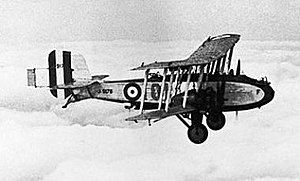Boulton Paul Sidestrand
| Sidestrand | |
|---|---|
 |
|
| Role | Bomber |
| Manufacturer | Boulton Paul |
| Designer | H.A. Hughes |
| First flight | 1926 |
| Introduction | 1928 |
| Retired | 1936 |
| Primary user | Royal Air Force |
| Number built | 20 (four Sidestrands were converted into the Boulton Paul Overstrand) |
| Variants | Boulton Paul Overstrand |
The Boulton Paul P.29 Sidestrand was a twin-engine biplane medium bomber of the Royal Air Force. Named after a village on the Norfolk coast near Boulton & Paul's factory in Norwich, the Sidestrand first flew in 1926 and entered service in 1928. It remained in service until 1936, equipping No. 101 Squadron RAF. It was an agile and relatively fast aircraft that was capable of aerobatic manoeuvres such as loops, rolls and spins.
Boulton & Paul Ltd of Norwich built a series of twin-engined biplanes starting with the Bourges of 1918, which although not ordered into production, had demonstrated excellent performance and manoeuvrability, followed by the all-metal Bolton of 1922 and the smaller Bugle of 1923. In 1924, the Air Ministry issued Specification 9/24 for an all-metal, twin engined medium bomber, with an order for two prototypes following early in 1925. The first aircraft flew in 1926, piloted by C. A. Rea, Boulton & Paul's first full-time test pilot.
The village of Sidestrand, chosen for the aircraft name, was the home of the Secretary of State for Air, Samuel Hoare Only 20 Sidestrands were built, the first two being equivalent prototypes, were called the Sidestrand Mk I. Originally intended to be powered by two Napier Lion inline engines, the Mk I was eventually fitted with 425 hp (317 kW) Bristol Jupiter VI radial engines, which also powered the first six production Sidestrands, known as the Sidestrand Mk II. The remaining twelve aircraft were powered by 460 hp (343 kW) Jupiter VIIFs as the Sidestrand Mk III. The six Mk IIs were re-engined to bring them up to the Mk III specification.
...
Wikipedia
